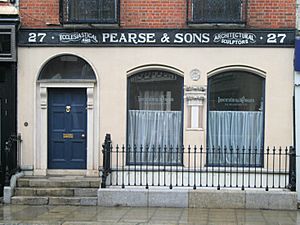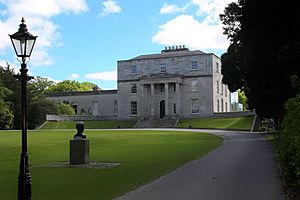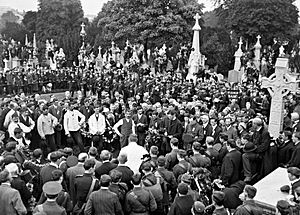Patrick Pearse facts for kids
Quick facts for kids
Patrick Pearse
|
|
|---|---|
| Pádraig Anraí Mac Piarais | |
 |
|
| Born |
Patrick Henry Pearse
10 November 1879 Dublin, Ireland
|
| Died | 3 May 1916 (aged 36) Kilmainham Gaol, Dublin, Ireland
|
| Resting place | Arbour Hill Prison |
| Other names | Pádraig Pearse |
| Education | CBS Westland Row |
| Alma mater | University College Dublin King's Inns |
| Occupation |
|
| Parent(s) | James Pearse Margaret Brady |
| Military career | |
| Allegiance | Irish Republican Brotherhood Irish Volunteers |
| Years of service | 1913–1916 |
| Rank | Commander-in-chief |
| Battles/wars | Easter Rising |
| Signature | |
Patrick Henry Pearse (also known as Pádraig or Pádraic Pearse; Irish: Pádraig Anraí Mac Piarais; 10 November 1879 – 3 May 1916) was an important Irish teacher, poet, writer, and political activist. He was a key leader in the Easter Rising of 1916. After he was executed, along with fifteen others, many people saw Pearse as a symbol of the rebellion and the fight for Irish freedom.
Contents
Early Life and His Irish Roots
Patrick Pearse was born in Dublin, Ireland, on November 10, 1879. He grew up with his brother, Willie, and his sisters, Margaret and Mary Brigid. Their family lived on Great Brunswick Street, which is now named Pearse Street in their honor. Their father, James Pearse, had a successful stonemasonry business, which gave the family a comfortable life.
Patrick's mother, Margaret Brady, came from a family in County Meath who spoke Irish. Her family's love for the Irish language and culture greatly influenced young Patrick. He also learned a lot about Irish history and heroes from his family. His maternal grandfather was part of the 1848 Young Ireland movement, which sought Irish independence.
Pearse loved books and learning. He decided at a young age to dedicate his life to helping Ireland become independent. His early heroes were ancient Gaelic folk heroes like Cúchulainn. Later, he became very interested in leaders of past Irish movements, such as Theobald Wolfe Tone and Robert Emmet.
Becoming an Irish Language Champion
Patrick Pearse quickly became involved in the Gaelic revival. This was a movement to bring back the Irish language and culture. In 1896, when he was just 16, he joined the Gaelic League (Conradh na Gaeilge). This group worked to promote the Irish language. By 1903, at age 23, he became the editor of the League's newspaper, An Claidheamh Soluis ("The Sword of Light").
Pearse studied at University College Dublin and became a Barrister-at-Law in 1901. He even represented a poet who was fined for having his name displayed in Irish on his donkey cart. Although they lost the case, it became a symbol of the struggle for Irish rights. Pearse wrote that the decision meant "Irish is a foreign language on the same level with Yiddish."
St. Enda's: A New Kind of School
Pearse believed that language was essential to a nation's identity. He felt that the Irish school system at the time taught students to be more like Englishmen. He wanted an alternative that would help save the Irish language from disappearing.
In 1908, he opened his own bilingual school for boys called St. Enda's School (Scoil Éanna). It was located in Ranelagh, Dublin. Students were taught in both Irish and English. His brother Willie, their mother, and sisters helped make the school a success. Pearse even took students on trips to the Gaeltacht, areas in western Ireland where Irish is still spoken daily.
Later, Pearse moved the school to a beautiful new location called The Hermitage in Rathfarnham, County Dublin. This place is now the Pearse Museum. He also helped start Scoil Íde (St Ita's School) for girls. However, these new schools caused financial problems for Pearse. In 1914, he traveled to the United States to raise money to keep the boys' school open.
The Irish Volunteers and Home Rule
In 1912, a plan called the Irish Home Rule Bill was introduced. This bill aimed to give Ireland more control over its own affairs, but it would still be part of the United Kingdom. Pearse welcomed the bill but also warned that if Ireland was "betrayed," there would be "red war."
In November 1913, Pearse joined the Irish Volunteers. This group was formed to protect Ireland's rights and liberties. He wrote that his work as an Irish Nationalist might lead him and others to a "greater adventure."
The Home Rule Bill was delayed because of World War I. This upset many Irish nationalists who felt that Ireland's freedom was being put on hold.
Joining the Secret Brotherhood
In December 1913, Pearse secretly joined the Irish Republican Brotherhood (IRB). This organization wanted to completely overthrow British rule in Ireland and create an independent Irish Republic. Pearse became a high-ranking member of both the IRB and the Irish Volunteers. He helped the IRB take control of the Volunteers to plan a rebellion.
By 1915, Pearse was part of the IRB's secret Military Council. This small group began planning for an uprising while the war was happening in Europe.
On August 1, 1915, Pearse gave a famous speech at the funeral of a Fenian leader named Jeremiah O'Donovan Rossa. He said that "Life springs from death; and from the graves of patriot men and women spring living nations." He ended his speech with a powerful message: "while Ireland holds these graves, Ireland unfree shall never be at peace."
The Easter Rising and His Death
In 1916, Pearse, on behalf of the IRB, gave the order for the Irish Volunteers to begin a rebellion on Easter Sunday. However, the Chief of Staff, Eoin MacNeill, tried to stop the uprising because promised weapons from Germany did not arrive. This caused confusion, and the IRB had to issue a last-minute order to go ahead with the plan the next day. This greatly reduced the number of people who took part.
The Easter Rising began on Easter Monday, April 24, 1916. Pearse stood outside the General Post Office (GPO) in Dublin and read the Proclamation of the Irish Republic. This document declared Ireland an independent republic. Pearse was chosen as the President of this new Republic.
After six days of fighting, with many people hurt and buildings destroyed, Pearse ordered the rebels to surrender.
Pearse and fourteen other leaders, including his brother Willie, were tried by a military court and executed by firing squad. Patrick Pearse, Thomas Clarke, and Thomas MacDonagh were the first to be executed on May 3, 1916. Patrick Pearse was 36 years old. The British General in charge, Sir John Maxwell, did not allow the Pearse brothers' bodies to be returned to their family. He feared their graves would become "martyrs' shrines" and cause more trouble.
His Writings and Legacy

Pearse wrote many stories and poems in both Irish and English. Some of his most famous English poems include "The Mother," "The Fool," and "The Rebel." He also wrote plays in Irish, like The King and The Singer. His short stories in Irish include Íosagán ("Little Jesus").
He wrote essays about education, politics, and language. One important essay was "The Murder Machine," where he shared his ideas on how education should be. He also wrote "The Coming Revolution" and "Ghosts."
Pearse was also known for creating republican lyrics for the old Irish song, "Oró Sé do Bheatha 'Bhaile." He was a very important literary critic and poet during the Gaelic revival. He helped bring modern poetry into the Irish language. Some experts believe his death was a great loss for modern Irish literature.
Remembering Patrick Pearse
For many years after the Rising, Patrick Pearse was seen as a hero and a symbol of Irish independence. His ideas influenced many Irish nationalists.
Many places and institutions in Ireland are named after Patrick Pearse to remember his role in Irish history:
- The building where his school, St. Enda's, was located is now the Pearse Museum in Rathfarnham, Dublin.
- Pearse Street and Pearse Square in Dublin were renamed in 1926 to honor him and his brother Willie. Many other towns in Ireland also have streets, roads, and parks named Pearse.
- Pearse Station in Dublin was renamed in 1966.
- In 1966, a silver ten shilling coin was minted with Patrick Pearse's image. It is the only Irish coin to feature someone from Irish history or politics.
- Postage stamps commemorating Pearse have been issued by the Irish postal service.
Schools and Colleges
- Cullenswood House, the first home of St. Enda's, now houses a primary school called Lios na nÓg, which teaches through the Irish language.
- There are several other schools and colleges named after Pearse, including Pearse College of Further Education in Dublin and Coláiste an Phiarsaigh in County Cork.
Sports Clubs and Venues
Many Gaelic Athletic Association (GAA) clubs and playing fields across Ireland are named after Pádraic or both Pearse brothers. Some examples include:
- Pearse Stadium in Salthill, Galway.
- Pearse Park in Longford.
- CLG Na Piarsaigh in Cork and Limerick.
- Ballyboden St. Enda's GAA in Dublin, named after Pearse's school.
There are also soccer clubs named Pearse Celtic FC in Cork and Dublin.
Images for kids
See also
 In Spanish: Patrick Pearse para niños
In Spanish: Patrick Pearse para niños






